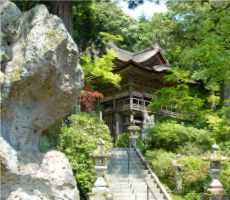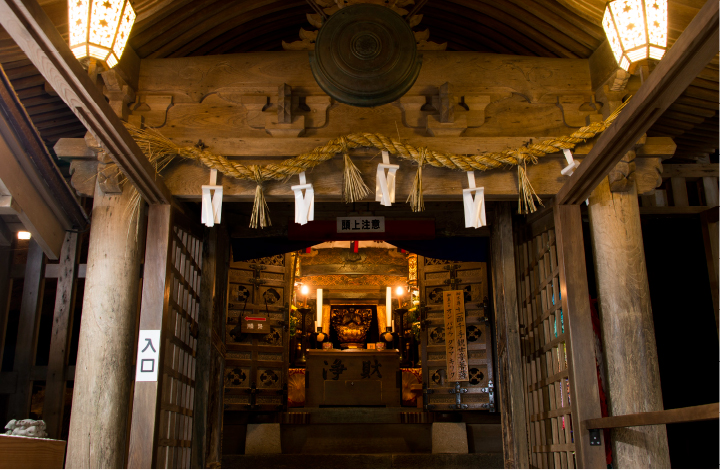
Honden (Main Shrine)
The Collective Name for Daihi-kaku (Hall of Compassion),
Karamon (Chinese Gate), and Honden
The honden, which had been destroyed in war, was reconstructed by Maeda Toshitsune in 1642. It has an unusual structure: it was built close to a rock wall, and has no roof on the side nearest the rock wall. It is made of precious imported hardwood. The roof is covered with wood shingles, and has a protruding section at the front center. The transom windows on all sides feature openwork carved by Yamagami Zen’emon (One of the most famous architects in Ishikawa Prefecture’s history, also known as the master carpenter for Zuiryuji Temple in Takaoka City, Toyama Prefecture, a national treasure). The honden was designated as a national treasure in 1941, dismantled and repaired in 1949, and designated as an important cultural property under the new Cultural Properties Protection Law in 1950. The Iwaya-tainai-kuguri cave is located inside, where the Eleven-faced Thousand-armed Kannon (the principal object of worship at the temple) is enshrined.
The Meaning of Iwaya-tainai-kuguri
Long ago in Japan, caves were called Iwaya, and were sometimes used as dwellings. Caves also served as the locations of deaths and funerals. As a result, caves came to be considered representative of entrances to the other world, and the wombs of mothers as well. In caves, spirits are formed in the wombs and born as human beings, then they return (death) and are reborn (life), repeating this cycle. The Iwaya-tainai-kuguri cave provides visitors with an opportunity to experience that cycle.
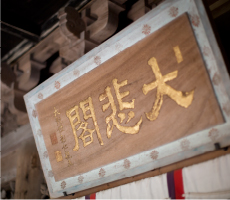 Tablet at the entrance of Daihi-kaku (the Hall of Compassion)
Tablet at the entrance of Daihi-kaku (the Hall of Compassion) The inside of the Iwaya-tainai-kuguri cave
The inside of the Iwaya-tainai-kuguri cave The Honden (the Main Shrine) is located in an elevated position
The Honden (the Main Shrine) is located in an elevated position
Kondo Keo-den (Central Worship Pavilion)
The Venue for All Buddhist Memorial Services

The Kondo was reconstructed in 1990, 650 years after it was consumed by the fires of war during the Northern and Southern Dynasties era. It was built entirely of hinoki cypress wood in a Japanese architectural style of the Kamakura era (1185–1333). All of the Buddhist services held in the inner sanctum are held here.
The Eleven-faced Thousand-armed Kannon (7.8 m tall, made of pieces of hinoki cypress wood) was created by the Kyoto Buddhist sculptor Matsuhisa Hourin. In addition, a Hakusan Mandala, a statue of the monk Taicho, and a statue of the retired Emperor Kazan are enshrined here. The wall is decorated with works created by a local artist, depicting the Hakusan faith in which Buddhism and Shintoism are unified.
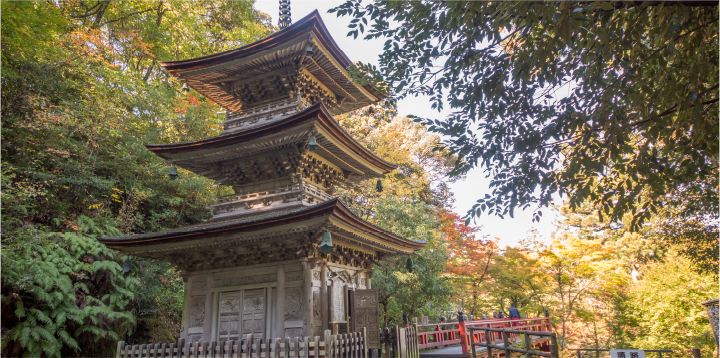
The Three-storied Pagoda (Important Cultural Property of Japan)
Architecture Created through
the Longstanding Accumulation of Culture
The grounds of Natadera Temple are full of natural beauty, harmonizing with a number of buildings of various sizes, including the Hondo (main shrine), Kondo (central worship pavilion), Shoro (bell tower), and the three-storied pagoda. These buildings provide visitors with a sense of wabi-sabi, or quietly subdued refinement. Seven buildings in the precincts have been designated by the national government as important cultural properties, and two locations have been designated as places of scenic beauty. We hope you will be able to enjoy them, along with the collection of historical treasures at the temple, as you consider the flow of time and the accumulation of culture.
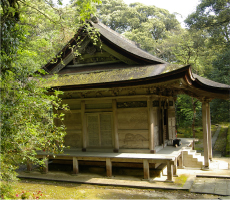 Goma-do (Hall of Homa)
Goma-do (Hall of Homa)
(Important Cultural Property of Japan)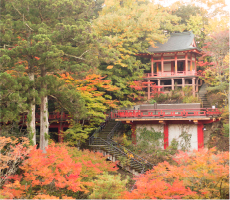 Chinju-do Observation Platform
Chinju-do Observation Platform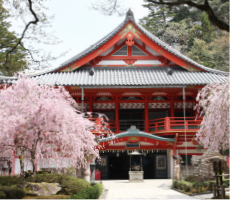 Kondo Keo-den
Kondo Keo-den
(Central Worship Pavilion)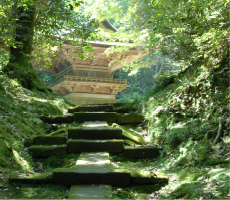 Shoro (Bell Tower)
Shoro (Bell Tower)
(Important Cultural Property of Japan)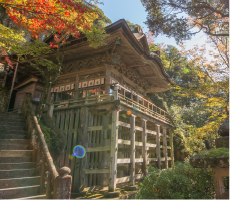 Daihi-kaku (Hall of Compassion), Karamon (Chinese Gate), and Honden
Daihi-kaku (Hall of Compassion), Karamon (Chinese Gate), and Honden
(Important Cultural Property of Japan)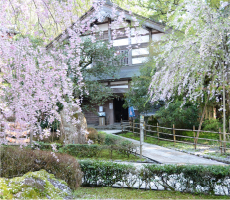 Fumon-kaku (House of Sutras)
Fumon-kaku (House of Sutras) Statues of Fujin and Raijin
Statues of Fujin and Raijin
(the Wind and Thunder Gods) Fujin-maru Sword
Fujin-maru Sword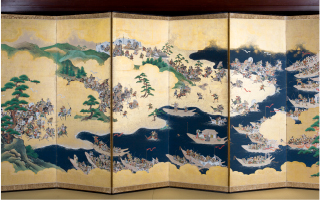 Folding Screen with Painting of a Scene from the Genpei War
Folding Screen with Painting of a Scene from the Genpei War
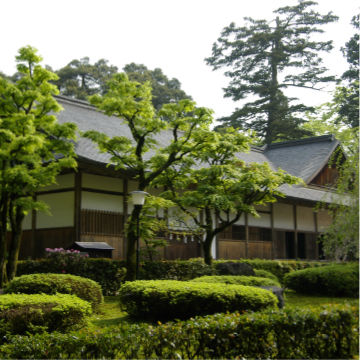
A Reception Hall
that Provides Peace of Mind
The currently existing shoin reception hall was reconstructed in 1637 by Maeda Toshitsune (the third lord of the Kaga Domain) after the temple buildings were destroyed in wars that lasted from 1573 to 1593. It was built in the buke-shoin-zukuri style of architecture, featuring various characteristics that differentiate it from other shoin-zukuri buildings, such as the unusual entrance ceiling made of clay. In 1953, it was designated as an important cultural property of Japan. (Separate admission fee required.)
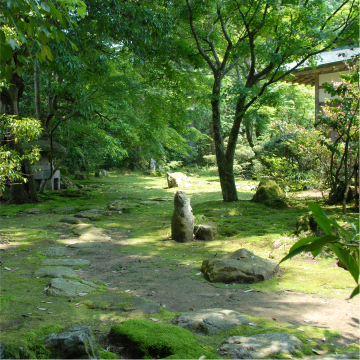
A Garden Demonstrating
the Essence of Japanese Beauty
The garden that can be seen from the shoin was created by Wakebe Bokusai, a magistrate of the Kaga Domain in charge of garden-making, under the guidance of Kobori Enshu, a gifted master of the tea ceremony who boasted a variety accomplishments and versatile talents. The garden features a stone walkway, upright stones placed in various spots, an old chinquapin tree, and a huge cedar tree, all of which are covered with moss, adding a sense of time-honored elegance. This is the oldest garden in Ishikawa Prefecture, and was designated as a place of scenic beauty by the Ministry of Education, Science and Culture on April 2, 1929. (Separate admission fee required.)
The Nyozean tea-ceremony arbor, located on the northwest corner of the garden, was built by Sen Soshitsu IV, the fourth head of the Urasenke school of the Japanese tea ceremony, for Maeda Toshitsune. According to legend, Toshitsune used this arbor on a regular basis after his retirement.
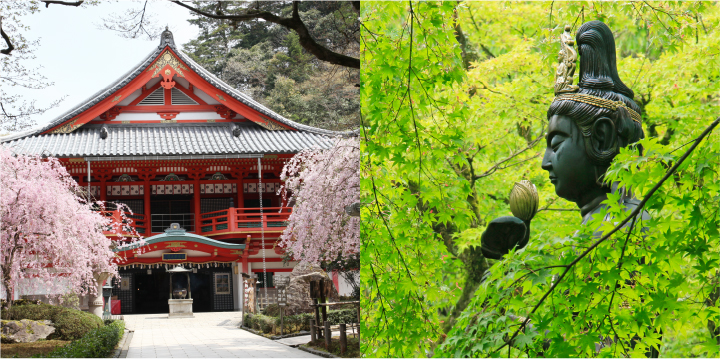
Blessed with Simple yet
Rich Natural Beauty throughout the Year
In spring, the grounds are filled with splendid cherry blossoms. In summer, the moonlight reflects beautifully on the water’s surface in the Kigan-Yusenkyo (enchanted rock outcropping) garden. The fall colors are redder than red itself, while winter brings snow piling up steadily yet silently. The scenic beauty of Natadera Temple changes from season to season, with each visit revealing something new. There is something profound in this tranquil natural splendor, representing the beauty of wabi-sabi, the quietly subdued refinement that Japan is known for. Take a deep breath and feel yourself come closer to nature.





